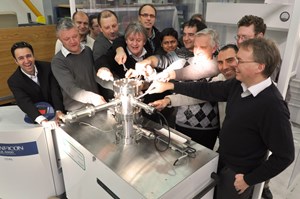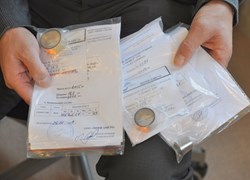ITER NEWSLINE
163
Keeping ITER's microscopic enemies at bay
Robert Arnoux
Keeping ITER's microscopic enemies at bay

CEA Vacuum Group offered their ITER counterparts ''a nice piece of real-estate'' in the form of a working space in one of the CEA-IRFM buildings, close to the Tore Supra installation.
Leaks and impurities are the giant ITER's most feared enemies. A submicron-size crack in a vacuum vessel weld, a puff of particles ripped from a plasma-facing component—these events would be enough to severally degrade the machine's performance and eventually bring it to a halt.
Keeping these microscopic enemies at bay is one of the responsibilities of the ITER Vacuum Group. "We have a mandate to assure vacuum quality," explains Liam Worth, the Group's Vacuum Leak Technical Engineer. "This means scrupulous testing during assembly and careful qualification of the materials that go into the vacuum vessel."
A 600 m² ITER vacuum laboratory will be the centre of leak-testing activity and vacuum qualification during the main assembly phase of the ITER device.
In the meantime and until the facility becomes available, the ITER Vacuum Group will meet urgent vacuum qualification needs by using a "temporary vacuum laboratory" ... courtesy of the neighbouring research centre CEA.
Some eight months ago "an informal conversation around a cup of coffee" with CEA colleagues provided an unexpected opportunity. CEA Vacuum Group was offering their ITER counterparts "a nice piece of real-estate" in the form of a 60 m² working space in one of CEA-IRFM's buildings, close to the Tore Supra installation.
Several meetings and a letter of intent later, the deal was sealed. "Having a temporary space at the CEA gives us the opportunity to begin building an effective facility ready to meet the challenge of construction," explains Jean Louis Bersier, ITER Vacuum Technical Engineer responsible for the planned full-scale ITER vacuum laboratory, which will ultimately be housed on the ITER site.

Fresh from Russia: samples of material proposed to be used in the ITER divertor will be tested in the Vacuum Group's test rig.
Equipped with an outgassing rig (outgassing is the process by which materials release the gas particles that are trapped on their surface and within their bulk), a leak detector and a laminar flow bench, the "temporary vacuum laboratory" will meet the immediate needs of ITER with minimum cost to the project.
Results obtained in the ITER temporary vacuum laboratory will feed the database of materials compatible not only with vacuum but with the very unique ITER vacuum—an environment where an artificial Sun ten times hotter than the actual one shines through an "atmosphere" one million times thinner than the air we breathe.
return to Newsline #163



